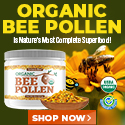
Mycelium Running: How Mushrooms Can Help Save the World (Book Review)
Friday, March 07, 2008 by: Teri Lee Gruss
Tags: mushrooms, health news, Natural News
- CLOT SHOT PLANDEMIC UNFOLDING: Fibrous, rubbery clots caused by covid injections have prion-like seeding activity
- Widespread social and economic unrest: Steve Quayle issues urgent financial warning of imminent asset collapse in new interview with Mike Adams
- DEATH by VACCINE or face PRISON time: Canadian Freedom Convoy leaders CONVICTED for protesting forced vaccination during the Covid Plandemic
- How to detox from metals falling out of the sky
- Aerosolized bioweapons? Strange “diploid biomasses” falling out of the sky in Florida captured under the microscope
- How Israeli military-connected corporations are secretly controlling your online privacy
- How the peanut allergy epidemic was fueled by faulty science and institutional arrogance
- Kiss Your Genetic Privacy Good-Bye! 23andMe Gets Green Light to Sell Your Intimate Genetic Details to Anyone They Want
- Analysis: The coming economic collapse, a mass uprising and Trump's three secret weapons to halt the growing revolt
- Thimerosal is 50 percent MERCURY and NO it has NOT been removed from vaccines - that was a BIG FAT LIE the CDC told vax skeptics to keep them vaxxed up and dying
- “Rockefeller Medicine Men”: Today’s healthcare crisis stems from the creation of the American medical establishment
- Mike Adams releases country western hit single: Goin’ Back in Time is Comin’ Home
- Global financial Ponzi scheme collapses in real time as markets plummet, Mike Adams and Steve Quayle warn of impending chaos
- EU takes aim at Elon Musk's X with potential $1 billion fine under Digital Services Act
- Defunding DEADLY mRNA jabs: Government funding for mRNA technology being scrutinized and sidelined until proven "safe and effective" for real
- European Court of Justice: Healthcare professionals who promoted or administered COVID-19 vaccines are CRIMINALLY LIABLE for any harm caused
- New York governor signs controversial gun control measure, sparking Second Amendment concerns
- Washington State expands hate crime bill but ignores left-wing violence against Tesla owners
- Aerosolized bioweapons? Strange “diploid biomasses” falling out of the sky in Florida captured under the microscope
- European Court of Justice: Healthcare professionals who promoted or administered COVID-19 vaccines are CRIMINALLY LIABLE for any harm caused
- Newly released JFK files reveal Pentagon's role in creating Lyme disease and covid in the same lab
- Analysis: The coming economic collapse, a mass uprising and Trump's three secret weapons to halt the growing revolt
- FBI imposed gag order on agents to silence Hunter Biden laptop truth before 2020 election, new chat logs reveal
- Britain’s descent into police state censorship: Parents raided for questioning their daughter’s school system online
- “Project Aldrin”: Senate probes Meta's alleged censorship dealings with China
- Kiss Your Genetic Privacy Good-Bye! 23andMe Gets Green Light to Sell Your Intimate Genetic Details to Anyone They Want
- Oncologist warns of ‘terrifyingly aggressive’ cancers in children, linked to immune suppression from COVID vaccines
- Mike Adams releases country western hit single: Goin’ Back in Time is Comin’ Home
- Utah governor allows ban on LGBT pride flags in public buildings and schools, will take effect without his signature
- AI-powered forecasting model proves more accurate than traditional systems at predicting the weather
- When antibiotics are unavailable, natural ANTIMICROBIAL compounds become essential first line defenses against infection
- German researchers find link between mRNA vaccines and GENETIC CHANGES that precede CANCER and AUTOIMMUNE DISORDERS
- Defunding DEADLY mRNA jabs: Government funding for mRNA technology being scrutinized and sidelined until proven "safe and effective" for real
- The Health Ranger releases “Vaccine Zombie” song and music video, using AI-animated zombies for the music video
- Dr. Mary Talley Bowden drops bombshells about children being permanently damaged by mRNA jabs during Tucker Carlson interview
- The hidden war above: Chemtrails, HAARP and the battle for planetary control
- Newly released JFK files reveal Pentagon's role in creating Lyme disease and covid in the same lab
- California's social media censorship law struck down: A victory for free speech or a threat to online safety?
- The Health Ranger releases “Vaccine Zombie” song and music video, using AI-animated zombies for the music video
- Dr. Mike Yeadon releases 15-minute testimony - WATCH - about genocidal intent of COVID “vaccines”
- EPA advisor admits the agency is funneling billions to climate groups ahead of Trump’s return to White House
- Rep. Nancy Mace introduces bill to ban biological males from female facilities on federal property
- Mike Adams releases country western hit single: Goin’ Back in Time is Comin’ Home
- Florida takes a stand: DeSantis proposes permanent ban on mRNA vaccine mandates
- Sugarcane extract superior to cholesterol-lowering drugs?
- Survival 101: Effective EMF blocking techniques
- OpenAI whistleblower who dissented against how the company trained ChatGPT found dead
- CONSERVATIVES SOUND THE ALARM: Big Pharma and the Left trying to force $32 billion money grab from America’s seniors into year-end spending deal
- Pilots report mysterious lights 'moving at extreme speeds' across Oregon skies
- Attorney and TikTok influencer explains how he was offered hundreds of dollars to make false claims about Trump, Republicans
- Trump reverses course on Gaza plan, says “nobody is expelling Palestinians”
- Trump expected to choose Kelly Loeffler as his agriculture secretary even though she was caught INSIDER TRADING during COVID
- MEDICAL BOMBSHELL: FDA admits Covid mRNA 'Vaccines' CAUSE CANCER
- Marketing director responsible for WOKE Jaguar rebrand is also an LGBT activist who supports Black Lives Matter
- Red Cross issues warning to stop blood plasma donations from vaccinated people
- Scientists confirm: GENIUS brain function can be spontaneously unleashed in humans without any apparent cause
- EPA advisor admits the agency is funneling billions to climate groups ahead of Trump’s return to White House
- HYSSOP: What research reveals about the health benefits of this ancient holy herb
- Two containers with completed ballots fall out of truck in Florida
- Fully vaccinated about to see “tsunami” of illness and death, warns virologist
- Global leaders unite to clamp down on “misinformation” with UN-backed Cascais Declaration
- Newly released JFK files reveal Pentagon's role in creating Lyme disease and covid in the same lab
- BREAKING: 2025 NDAA authorizes mandatory military draft of WOMEN across America… as Pentagon pursues global NUCLEAR war with both Russia and China at the same time
- Michael Yon warns of a ZIONIST TAKEOVER in Trump’s second administration
- Ozempic and Wegovy weight loss drugs are injectable LIZARD VENOM PEPTIDES that may unleash a devastating wave of organ failure… side effects align with symptoms of SNAKE BITES
- BOMBSHELL: DNA testing kits are a SCAM to develop ethnic-specific bioweapons
- The Health Ranger releases “Vaccine Zombie” song and music video, using AI-animated zombies for the music video
- Israeli soldiers accused of even more torture and abuse in the West Bank
- These 13 countries just signed an agreement to engineer a global FAMINE by destroying food supply
- NASA admits that climate change occurs because of changes in Earth’s solar orbit, and NOT because of SUVs and fossil fuels
- RFK Jr. clears key hurdle: Sen. Susan Collins backs controversial HHS nominee, signaling a new era for health policy
- Sermon 30: How Jesus reveals Caesar’s FAKE CURRENCY and FALSE AUTHORITY
If the subtitle How Mushrooms Can Help Save the World intrigues you, it should. Paul Stamets' thirty years of experience in "engaging fungi", his original theories and research will reveal a world that many of us never knew existed. He calls Mycelium Running "A mycological manual for rescuing ecosystems".
The text is divided into three parts with a foreword by the author's long time friend Dr. Andrew Weil. 360 high quality photos and concise, useful graphs and charts enrich the text. You will see mushrooms the likes of which you never imagined.
Mr. Stamets has a wonderful writing style; friendly, funny and scientific all at the same time. He describes fungi as the "grand recyclers" of nature, their cobweb like growth under logs as "mycomagicians".
Part One, The Mycelial Mind, contains four chapters:
* Mycelium as Nature's Internet
* The Mushroom Life Cycle
* Mushrooms in Their Natural Habitat
* The Medicinal Mushroom Forest
Stamets describes mycelium as "the neurological network of nature" that can "expand to thousands of acres in size in cellular mats achieving the greatest mass of any individual organism on this planet".
Mycelium is a single-celled organism that travels several inches a day. That means there is only one cell wall that protects this organism from pathogens, yet it thrives more prolifically that any plant or animal on the planet.
In fact, it is mycelium's vast structural network that is responsible for decomposing plant debris, at the same time providing nutrients to the plant and animal kingdoms. In other words, mycelium is earth's life support system and should be understood, respected and protected as such.
A mushroom is the fruit of mycelium. They produce spores capable of traveling great distances on the wind, on clothing, in animal feces and even on envelopes and packages in our mail.
There are four types of fungi: saprophytes, parasites, mycorrhizal and endophytes. The saprophyte subtype is largely responsible for recycling organic debris and providing nutrients to the plant and animal world.
Mycorrhizal fungi are vital to the health of forests because it transports nutrients to different species of trees.
The chapter The Medicinal Mushroom Forest discusses the ancient knowledge of the value of mushrooms to both the human body and the forest ecosystem with useful charts of commonly collected wild edible mushrooms from NW North America including chanterelles, matsutake and hedgehogs.
Various mushroom varieties possess potent anti-microbial properties. The author notes that a "moldy cantaloupe sent to an army research lab in 1941" led to the identification and extraction of strains of penicillium chrysogenum that led to the commercial synthesis of penicillin.
Mr. Stamets' own research led to the discovery that the extract of mycelium from the mushroom Fomitopsis officinalis "protects human blood cells from infection by orthopox viruses including the family of viruses that includes smallpox."
Specific varieties of mushrooms possess antiviral activity against such viruses as hepatitis B, herpes simplex, HIV, influenza, pox, and tobacco mosaic virus. A useful table lists various mushrooms and their antiviral activities.
Several varieties of mushrooms are sources of other medicinal compounds including triterpenoids and glycoproteins. Pages 38-39 provide a cross index of Mushrooms and Targeted Therapeutic Effects including mushroom activity against specific cancers.
Mr. Stamets presents strong evidence that fungi from old growth forests have potential as sources for new and vital medicines. And he emphasizes the essential importance of preserving this priceless resource.
Part II - Mycorestoration
In Mycorestoration the author presents his original thought, theories and research into how mycelium and their fruit, mushrooms, can be harnessed for uses that support the health of humans and our ailing planet. In this fascinating section of the book, the author presents the reader with "fungal opportunities underfoot".
These original concepts are presented in four forms: Mycofiltration, Mycoforestry,Mycoremediation and Mycopesticides.
Mycorestoration is defined as the selective use of fungi to repair or restore the weakened immune systems of environments.
Mycofiltration uses mycelium as a membrane to catch and filter upstream contaminants including microorganisms, pollutants and silt. Talk about filtration capacity, Mr. Stamets says that "more than a mile of mycelial cells can infuse a gram of soil".
The text illustrates how we can use mycelium on farms, in our own urban and suburban environments, in watershed districts, in factories, on roads and other stressed habitats to filter protozoa, bacteria, viruses, bacteria, silt and chemical toxins.
Mycelial mats, called "bunker spawn" mature in months and can be used for years to prevent downstream pollution. Mr. Stamets discusses his own research in microfiltration and presents directions for building and installing mycelium microfilters.
Mycoforestry is the use of fungi to sustain forest communities by preserving natural forests, recycling woodland debris, sustaining replanted trees with the goal of strengthening the forest ecosystem.
Mr. Stamets emphasizes that contrary to conventional thought our forests are not "renewable" resources and discusses how carbon cycles that fuel the food chain can take centuries, if not thousands of years to establish.
For example, in Oregon a honey mushroom mat found on a mountaintop covered over 2400 acres and is thought to be about 2200 years old. "Nurse" logs in this forest increase soil depth and enrich the habitat for the fungi, plant and animal kingdoms.
The reader must wonder how many regions like this exist on planet earth today.
According to the author, acceleration of this process is possible by using wood chips as a spawning medium for fungi. This method has the potential to prevent forest fires because as mycelium grows on the wood chips they draw moisture to the forest floor in a sponge like way.
Mr. Stamets urges forest pathologists to develop strategies that utilize mycelium to improve forest health.
Mycoremediation is the use of fungi to degrade or remove toxins from the environment. According to the author fungi can be used to degrade heavy metals including lead, and mercury, industrial toxins including chlorine, dioxin, PCBs and organophosphates.
This potential is viewed in the perspective of the hierarchy of organisms in the fungi, plant, bacterium and animal kingdoms, a hierarchy which begins and ends with fungi.
Photos in this chapter illustrate diesel contaminated soil "under attack" by oyster mushrooms which thrive on the contaminated soil and regenerate it by neutralizing the contaminant. When they die and rot they provide a healthy environment for new plant growth. The contaminated soil in which mushroom growth was not introduced remained just that, barren and contaminated.
The goal of mycorestoration is to match fungi species to contaminants to enable the "destruction of toxins that enable other restoration strategies".
Mycopesticides involve the use of fungi to control pest populations, including carpenter ants and termites. Mr. Stamets relates a personal story of how he used mycelium as a natural pesticide to rid his house of carpenter ants.
He has applied for patents to use this biotechnology which protect groundwater and habitats from damage by conventional toxic pesticides, as a natural method of eliminating termites, ants and flies. He calls the technology "green mycotechnology".
Part III - Growing Mycelia and Mushrooms includes six chapters:
* Inoculation Methods: Spores, spawns and stem butts
* Cultivating Mushrooms on Straw and Leached Cow Manure
* Cultivating Mushrooms on logs and stumps
* Gardening with Gourmet and medicinal mushrooms
* Magnificent Mushrooms: The Cast of Species
* Nutritional properties of mushrooms
This section introduces readers to methods for inoculation, cultivation and gardening with mushrooms. Excellent photos, graphs and charts help the reader to visualize and practically apply the processes.
Mr. Stamets says that the key to growing mushrooms is to first grow mycelium and that the most important technique is learning how to use wild, or natural spawn because it has the advantage of being acclimated to its habitat.
The mycelium grower is described as a "herdsman" and the mycomotto is "move it or lose it". The author explains that no matter how successful you may be at getting mycelium to grow it will "consume its habitat" and will move on, if not supplemented with its basic nutrient needs.
Stamets explains that "Your job is to become embedded into the mind-set of this digestive cellular membrane, to run with mycelium".
Using fungi in the garden builds soil, improves yield and decreases fertilizer requirements. Photos illustrate the increased size of vegetables grown in mycelium rich soil.
Edible mushrooms are good sources of protein, are very low in simple carbohydrates and fats and are high in antioxidants, selenium, potassium, copper, B vitamins and fiber.
Nutritional content of mushrooms depends on variety and where they are grown. For example, button mushrooms grown in Texas and Oklahoma contain higher levels of selenium than those grown in Florida and Pennsylvania.
Pages 198-199 provide a very useful chart listing the nutritional properties of 16 edible mushrooms.
Mushrooms are rich sources of enzymes including cellulose, lignan peroxidases, laccases, manganese superoxide dismutases, enzymes known for their ability to decompose plant fiber.
According to the author, enzyme inhibitors in mushrooms are protective against breast and prostate cancer. Aromatase inhibitors that interrupt the conversion of androgens to estrogens are significant to those at risk for breast cancer. 5 alpha reductase inhibitors are significant to those at risk for enlarged prostate and prostate cancer.
Graphs provide additional information on mushroom variety and content of these valuable nutritional compounds.
The final chapter of the book is Magnificent Mushrooms: The Cast of Species
This section provides in-depth descriptions, distribution, habitat, harvesting hints, nutritional profile, medicinal properties, flavor, preparation and cooking tips, mycorestoration potential and comments for a long list of mushrooms including shiitakes, oyster, and morels.
This is valuable, useful information for anyone interested in utilizing the benefits of mushrooms for health, both human and planetary.
Certainly Paul Stamets book Mycelium Running: How Mushrooms Can Save the World will grow the ranks of mycophiles world wide. Because the science of mycorestoration is in its infancy, Mycelium Running will likely inspire a new generation of mycologists to implement the author's original discoveries and make future discoveries of their own, discoveries that benefit both mankind and the environment.
As Dr. Andrew Weil said in the introduction "I find this book exciting and optimistic because it suggests new, nonharmful possibilities for solving serious problems that affect our health and the health of our environment".
Mycelium Running: How Mushrooms Can Help Save the World by Paul Stamets - Ten Speed Press, 2005. 339 pp 360 color photos
Other books by Paul Stamets:
* Growing Gourmet and Medicinal Mushrooms (2000)
* The Mushroom Cultivator with coauthor Jeff Chilton (1983)
Founder of fungiperfecti @ (http://www.fungi.com/) and (http://fungi.com/mycomeds/info.html)
About the author
Teri Lee Gruss, MS Human NutritionMushrooms at FETCH.news
Get independent news alerts on natural cures, food lab tests, cannabis medicine, science, robotics, drones, privacy and more.
Take Action: Support Natural News by linking to this article from your website
Permalink to this article:
Embed article link: (copy HTML code below):
Reprinting this article:
Non-commercial use OK, cite NaturalNews.com with clickable link.
Follow Natural News on Facebook, Twitter, Google Plus, and Pinterest
Science News & Studies
Medicine News and Information
Food News & Studies
Health News & Studies
Herbs News & Information
Pollution News & Studies
Cancer News & Studies
Climate News & Studies
Survival News & Information
Gear News & Information
News covering technology, stocks, hackers, and more



"Big Tech and mainstream media are constantly trying to silence the independent voices that dare to bring you the truth about toxic food ingredients, dangerous medications and the failed, fraudulent science of the profit-driven medical establishment.
Email is one of the best ways to make sure you stay informed, without the censorship of the tech giants (Google, Apple, Facebook, Twitter, YouTube, etc.). Stay informed and you'll even likely learn information that may help save your own life."
–The Health Ranger, Mike Adams












































